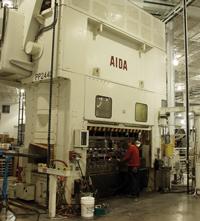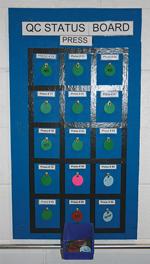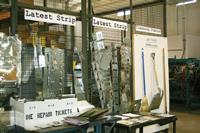Contributing Writer
- FMA
- The Fabricator
- FABTECH
- Canadian Metalworking
Categories
- Additive Manufacturing
- Aluminum Welding
- Arc Welding
- Assembly and Joining
- Automation and Robotics
- Bending and Forming
- Consumables
- Cutting and Weld Prep
- Electric Vehicles
- En Español
- Finishing
- Hydroforming
- Laser Cutting
- Laser Welding
- Machining
- Manufacturing Software
- Materials Handling
- Metals/Materials
- Oxyfuel Cutting
- Plasma Cutting
- Power Tools
- Punching and Other Holemaking
- Roll Forming
- Safety
- Sawing
- Shearing
- Shop Management
- Testing and Measuring
- Tube and Pipe Fabrication
- Tube and Pipe Production
- Waterjet Cutting
Industry Directory
Webcasts
Podcasts
FAB 40
Advertise
Subscribe
Account Login
Search
Driven to integrate
Automotive component stamper branches out, adapts to industry changes
- By Michael Bishop
- May 13, 2008
- Article
- Bending and Forming

A Parkview Metal Products worker operates a stamping press at the company's facility in Lake Zurich, IL. Parkview produces components for the automotive industry, consumer electronics, and barbecue grills.
Changes come often in the steel industry. An item manufactured in the U.S. today can be moved overseas next week. Domestic demand for a new product can grow quickly, and manufacturers need to adapt continuously to stay in business. Sometimes adapting means moving into new markets unrelated to the purpose envisioned by a company's founders. A business that sticks around long enough might eventually bear little resemblance to the version established at its inception.
This is the case for Parkview Metal Products, Lake Zurich, Ill. The company opened in 1950 as a tool and die shop near Wrigley Field in Chicago—hence the name Parkview. At first the metal forming company produced components for the television industry. A few years later it moved to another location in Chicago, where it remained for nearly 50 years. During that time it also opened a fabrication and tooling center in Bensenville, Ill. Parkview brought the stamping and fabrication businesses together under one roof in 2005, relocating the operations of both to Lake Zurich.
Parkview had to adapt to changes in the industry. As U.S. production of televisions bottomed out, the company shifted its focus to automotive, consumer electronics, and barbecue grill components. Parkview also had to adjust to a steel market that functions much differently than it did during the company's early years.
"It's a vastly different business than it was when it was founded," Parkview CEO Nels Leutwiler said. "In the earlier days of the industry, suppliers announced to the customers how big price increases were going to be every year. Now it's our customers announcing to us that they want their prices lowered, and we're getting squeezed by the steel companies. We're not just competing with other stampers in Chicago, we're competing globally."
All-purpose Operation
Parkview's capabilities include long-run stamping, short-run fabrication, value-added assembly, and tooling engineering and design. The company has 14 stamping presses, five turret punch presses, two laser cutting systems, 11 press brakes, and various welding operations occupying its 136,000-sq.-ft. shop. Running two shifts, the company employs 96 workers on the production floor and 25 in the office.
Stamping makes up two-thirds of the company's business, with the other third coming from fabrication. Parkview uses a variety of presses, from small, high-speed to 12-ft.-bed models, with some progressive-die models and a tryout press. The company also provides in-house tool and die design, construction, and maintenance. Even though the stamping and fabrication operations used to occupy two facilities—and as a result were run separately—Parkview has been working to integrate the two functions since the move.
"There are obviously a lot of synergies that are available," said Parkview Assistant Sales Manager Al Kempista. "[When] we work with customers, we [frequently] start out on a prototype basis. They might see that the job will go to long-run stamping down the road, but for the first year they'll only have a need for short-run fabricated parts, and we can offer that too. Everything associated with the life of that part is available within one facility."
Kempista said the company's integrated approach is helping secure additional business from its existing customers, while presenting a good selling point for new accounts.
"They don't have to go to one company for prototypes, one company for short-run fabrication, and then a third company for stamping," he added. "We can do it all here."
The integrated approach also helps when Parkview and a customer are working to establish volumes and gauge the viability of the product's design, according to Rick Steffen, director of sales and marketing. The company prefers to start working with a customer during the design stage, which allows it to oversee the part from conception through production.

Parkview has 14 presses at the Lake Zurich plant for long-run stamping operations. The company moved both its stamping and fabrication operations to the 136,000-sq.-ft. facility in 2005.
"The real value we bring to the equation is when we can get in early and assist them in design and specification of materials," Steffen said. "We come up with ideas, whether it's using a prefinished metal so that you don't have that secondary painting operation, or we can form something with tabs that interlock, rather than having to screw parts together."
Forming a Lean Strategy
Parkview thought it needed to make some internal changes and process improvements to remain competitive. With stamping its primary operation, the company focuses on keeping its presses running, with as little downtime as possible.
"We're not making any money if the press isn't going up and down," Kempista said. "And so we want to concentrate on those elements that are stopping the operation, decreasing the setup time, decreasing the amount of time needed to adjust a tool or do maintenance on a tool. We want to do that when the die isn't in the press."
Randy Esser, director of operations, said the company started implementing lean 5S initiatives a couple years ago and has further developed its lean program during the past several months.
During a given shift, it was uncertain at times whether the machines were scheduled to run, needed maintenance, or were undergoing quality testing. For supervisors, finding out usually required walking to the machine or searching for the area manager. The company began using status boards with color-coded tags in both its stamping department and its fabrication section to address the problem. Now, updating a machine's status is as simple as hanging a new tag on a hook under the corresponding machine number. A green tag shows that the machine is running. Red demonstrates downtime for maintenance or other reasons. Blue indicates setup and quality testing. And yellow means that workers are using the machine for prototyping.
Parkview also began using walk-about sheets at every machine to document each aspect of a production run. Equipment operators use the sheets to maintain an hourly count of the number of pieces produced, recorded next to an hourly goal. A daily cumulative total also is recorded to verify that the machine has met the cumulative goal. The sheets also document scheduled and unscheduled downtime.
In order to incorporate the sheets, the company first had to evaluate its processes, determine correct cycle times, and ensure each machine was operating as productively as possible, Esser explained. The walkabout process required a period of evaluation, adjustment, and trial, which Parkview began on its turret presses and lasers and expanded to the stamping presses and all other production cells.
"Just to go through that walkabout process with the cross-functional team, it took us the better part of an hour because we're all trying to understand what this process is about," Esser said. "[More recently] we went through the turret presses, the lasers, all the press brakes, and we did that probably in 20 minutes because everybody understands how it works. The documentations are ready to go. The folks on the floor know how to fill it out. We've gone through all those learning curves."
Other projects have included reducing the size of the packaging area; organizing and marking all supplies; calculating sales per employee; and chronicling all quality, safety, and productivity issues in a never-ending-improvement (NEI) document.
Pressing Challenges, Expanding Goals
Leutwiler and Kempista believe that growing and changing are the keys to Parkview's survival. With U.S. manufacturing challenged on a worldwide level, steel prices rising, and the industry continuing to consolidate, the company works to be as lean as possible and adapt to new markets.

Status boards in Parkview's stamping and fabrication departments let supervisors know which machines are running, down for maintenance, in setup mode, and in use for prototyping.
The business is working to expand both its range of services and its geographic presence. The company recently opened a satellite facility in Juarez, Mexico—relocating operations from a satellite plant in Las Cruces, N.M.—to shorten the logistical lines between it and its customers in Mexico. It also has expanded into health care and food service equipment; medical device enclosures; point-of-sale components; and louvered stainless steel panels and other parts used in food- warming equipment. In addition, the company is working to implement more automation, such as hardware assembly within the press and in-press welding.
Parkview's journey from a tool and die shop that produced television components to a diversified manufacturer with multiple operations shows an ability to adapt within a volatile market. The company believes its culture is changing for the better and plans to continue developing its 5S initiatives, increasing its on-time delivery, and reducing its scrap rate.
"It has been an incredible re-engineering process," Esser said. "Folks have jumped onboard [because] nobody can do it by themselves. It really is a team effort, all the way from the sales guys to the folks on the floor who are running the pieces of equipment."
About the Author

subscribe now

The Fabricator is North America's leading magazine for the metal forming and fabricating industry. The magazine delivers the news, technical articles, and case histories that enable fabricators to do their jobs more efficiently. The Fabricator has served the industry since 1970.
start your free subscription- Stay connected from anywhere

Easily access valuable industry resources now with full access to the digital edition of The Fabricator.

Easily access valuable industry resources now with full access to the digital edition of The Welder.

Easily access valuable industry resources now with full access to the digital edition of The Tube and Pipe Journal.
- Podcasting
- Podcast:
- The Fabricator Podcast
- Published:
- 04/16/2024
- Running Time:
- 63:29
In this episode of The Fabricator Podcast, Caleb Chamberlain, co-founder and CEO of OSH Cut, discusses his company’s...
- Trending Articles
Steel industry reacts to Nucor’s new weekly published HRC price

How to set a press brake backgauge manually

Capturing, recording equipment inspection data for FMEA

Are two heads better than one in fiber laser cutting?

Hypertherm Associates implements Rapyuta Robotics AMRs in warehouse

- Industry Events
16th Annual Safety Conference
- April 30 - May 1, 2024
- Elgin,
Pipe and Tube Conference
- May 21 - 22, 2024
- Omaha, NE
World-Class Roll Forming Workshop
- June 5 - 6, 2024
- Louisville, KY
Advanced Laser Application Workshop
- June 25 - 27, 2024
- Novi, MI



























